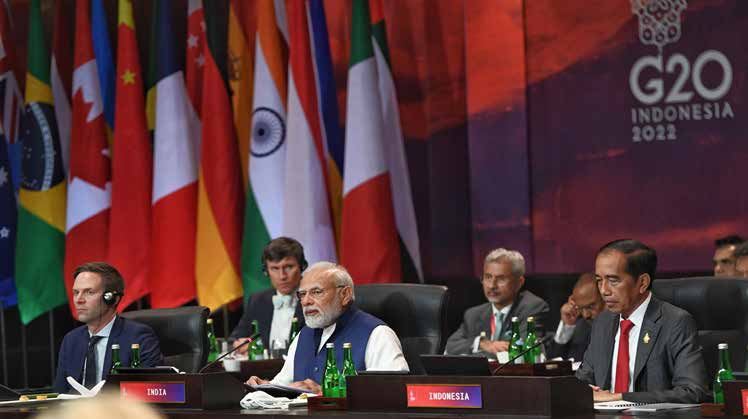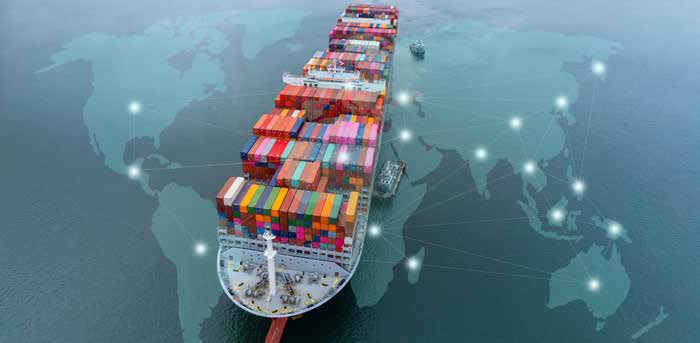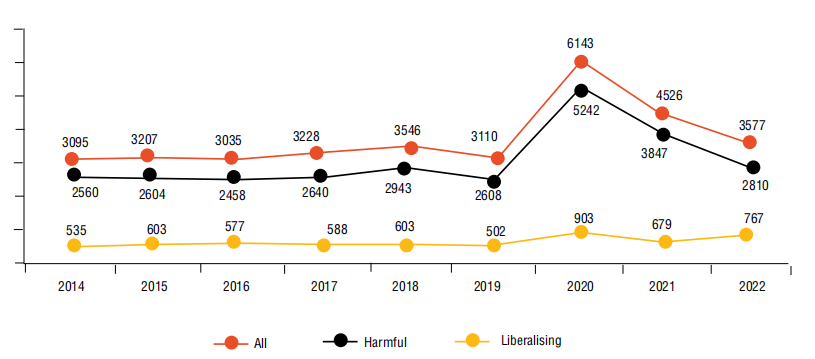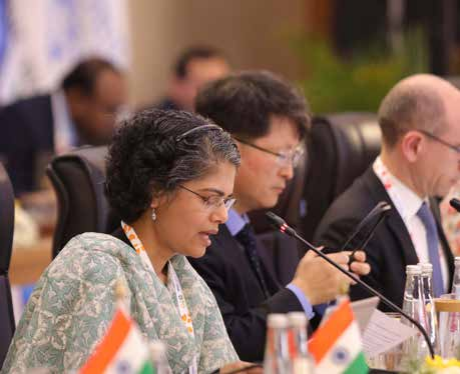Focus
The Spirit of One
IN less than a fortnight, India will be hosting the G20 Summit in New Delhi, on 9-10 September 2023, the culminating meeting of India’s assumption of the G20 Presidency for a year. The Summit will witness one of the largest gatherings of world leaders representing the 19 countries and the European Union who are G20 members, besides nine guest countries and heads of multilateral agencies. The theme of India’s G20 Presidency is ‘One Earth, One Family, One Future. When Prime Minister Narendra Modi addresses the opening session of the Summit, US President Joe Biden and President Xi Jinping of China will be among the honoured guests.
The G20 comprises Argentina, Australia, Brazil, Canada, China, France, Germany, India, Indonesia, Italy, Japan, Republic of Korea, Mexico, Russia, Saudi Arabia, South Africa, Türkiye, the United Kingdom and the United States and the European Union. Apart from the members, Bangladesh, Egypt, Mauritius, Netherlands, Nigeria, Oman, Singapore, Spain and UAE are invited as guest countries where Spain is a permanent guest.
The preparations to house the G20 delegations are in full swing, according to official sources. Hotels have been booked across Delhi, Noida, Gurugram, and Aerocity in the NCR. All the meetings of the G20 leaders will be held at Bharat Mandapam in the Pragati Maidan, which is also the venue for the ceremonial banquet. An important event on the Summit calendar will be a visit to Rajghat to pay tribute to Mahatma Gandhi.
A challenging year
It has by no means been an easy year globally since India assumed the Presidency on 1 December 2022: the world has been beset by the continuing geopolitica tensions arising from the Ukraine-Russia conflict and the resultant disruptions in supply chains, the slow pace of post-pandemic recovery and economic downturn in several major global economies among other issues. These global challenges are even jeopardising the effectiveness of multilateralism as a tool for global stability.
Assuming the Presidency under these demanding conditions was an enormous challenge for India that it faced squarely and achieved a fair amount of success. India’s effective handling of many of the challenges, especially the critical post-pandemic situation in the country has been commended globally.
India is currently part of the G20 Troika (concurrent past, present and future presidencies) comprising Indonesia, India, and Brazil, which marks the first time that the troika comprises three developing and emerging economies.

India is the 18th country to assume the G20 presidency. It took over from Indonesia on 1 December 2022 and will be handing over the baton to Brazil on 30 November 2023. India considers this G20 summit not merely as a diplomatic meeting, but a new responsibility that reflects the world’s trust on it. It is a good opportunity for India to demonstrate its potential especially before the developed world and to show its ability to emerge as a leader of the global south.
India’s G20 priorities, as stated by the government, are inclusive, equitable, and sustainable growth, women’s empowerment, digital public infrastructure and tech-enabled development, climate financing, global food security, and energy security, among others. Apart from focusing on these areas, India is expected to push issues that would positively affect poorer nations.

Indonesia made a beginning during its term by working in areas such as innovation, empowering MSMEs and vulner able groups, and collaboration between developed and developing countries.
In keeping with its priorities, the theme for India’s G20 presidency is ‘One Earth, One Family, One Future’ – to function around the principles of the universal sense of oneness:
- One Earth: heal the planet by encouraging sustainable and environment-friendly lifestyles based on Indian traditions.
- One Family: promote harmony within the human family by depoliticising pertinent supply chains of food, fertilisers, and medicines. This is done with the aim to prevent humanitarian crises due to geopolitical tensions.
- One Future: encourage honest conversations among the most powerful nations of the world regarding core issues of climate change and mitigation of risks posed by weapons of mass destruction to enhance global security.
Policy Priorities for the G20: One Earth, One Family, One Future
Policymakers urged to support vulnerable people and economies, protect the planet, and harness digital progress for all
AT a time of heightened uncertainties for the global economy, India’s strong performance remains a bright spot. So, it’s fitting that Group of Twenty finance ministers and central bank governors will gather in Bengaluru this week.
This will be another challenging year. But it could represent a turning point – with inflation declining and growth bottoming out. Indeed, while our latest projections show global growth slowing to 2.9 percent this year, we anticipate a modest rebound to 3.1 percent in 2024.
Look behind the headline numbers and we see emerging market and developing economies providing much of the momentum. We expect them to account for about four-fifths of global growth this year, with India alone expected to contribute more than 15 percent.
Global growth
Emerging market and developing economies are expected to account for about 80% of global growth this year and next. But beyond its role as a global growth engine, India is uniquely positioned to bring countries together.
In a world facing multiple challenges and rising geopolitical tensions, this leadership is critical – and beautifully captured in the theme of India’s G20 presidency: One Earth, One Family, One Future.
Let me share my view of what this spirit of ‘one’ represents for policymakers and for all of us as a global community.
First, one family means solidarity and protecting the vulnerable.
The reality is that growth is still subpar and price pressures are still too high. And, after three years of shocks, too many economies and people are still hurting badly.
Around the world, many households struggle to make ends meet because of the high cost of living. Millions cannot afford fuel for heating or cooking. Successive shocks have increased poverty, jeopardizing decades of progress. And, notwithstanding some easing in food prices, a record 349 million people in 79 countries face acute food insecurity.
Supporting the vulnerable is vital in all countries.
Fiscal measures should be temporary and laser-focused on protecting those who are most in need – always good practice, but even more important as countries grapple with increasingly limited resources and higher debt. In most countries, targeted measures need to be coupled with gradual fiscal tightening to rebuild buffers and ensure debt sustainability.
Meanwhile, bringing inflation back to target remains imperative. To get there, policymakers need to stay the course on monetary tightening. Aligning fiscal and monetary policies will help. Clear communication of these policy goals is vital to avoid a sudden repricing in financial markets.
While the global tightening cycle is necessary to ensure price stability, policymakers must be mindful of adverse spillovers to emerging and developing economies – including through a stronger US dollar and capital outflows. While financial conditions have improved since the G20 last met, providing some modest relief, we have seen how higher borrowing costs exacerbate the vulnerability of economies with heavy external debt burdens.
About 15 percent of low-income countries are in debt distress and an additional 45 percent are at high risk of debt distress. And among emerging economies, about 25 percent are at high risk and facing “default-like” borrowing spreads.
Here, solidarity means better mechanisms to restructure debt. Under the G20’s Common Framework, Chad reached an agreement with its creditors at the end of last year, and Zambia and Ghana are progressing toward debt resolution. But the ground rules need to be clarified and the processes made more efficient and effective.
To accelerate debt restructuring efforts, the IMF, World Bank, and India’s G20 presidency are convening a new Global Sovereign Debt Roundtable. This week in Bengaluru, we will meet in-person for the first time – and pave the way for creditors, both public and private, and debtor countries to work together, assess the existing shortcomings and best ways to tackle them.
In this more shock-prone world, some emerging and developing economies will also require additional financial support. So, a well-resourced global financial safety net, with the IMF at its centre, is more important than ever.
Think of how the Fund has stepped up to support our family of nations since the start of the pandemic. Over $272 billion for 94 countries of which about $34 billion was fast-disbursing emergency financing. The historic SDR allocation of $650 billion to boost our members’ reserves. And a new Food Shock Window provides fast access to resources for countries hit hardest by the food security crisis.
Now, further solidarity is needed to stand as one with the low-income and vulnerable members of our family to ensure they can still access concessional IMF financing in times of distress and to guard against future crises. Others with the strength and capacity to do so need to stand up and help address fundraising shortfalls – especially on subsidy resources in the Poverty Reduction and Growth Trust – and deliver additional contributions to the new Resilience and Sustainability Trust. This also means determination to advance the 16th General Review of Quotas so we can complete it by the end of the year.
Second, one earth means protecting our planet, our home.
We are witness to the increasingly severe and pervasive effects of climate change – an existential threat to humanity that we can only fight as a collective. We must band together as one family in defence of our one earth.
Our collective goal of delivering on the Paris Agreement and boosting resilience will require policies that can help redirect trillions of dollars towards green projects. Consider smarter regulation, price signals and well targeted subsidies that incentivize low-carbon investment or financial innovations that mobilize more private capital.
Here the IMF’s advice and financial support is working in tandem to mitigate the massive climate-related risks to economic and financial stability. The first wave of pilot countries accessing the Resilience and Sustainability Trust demonstrates how we are helping vulnerable countries set up the right policies and create an environment conducive to climate-friendly investments. Alongside this, we are coordinating with others – including multilateral development banks and the private sector – who have a key role to play in reducing investment risks
To be sure, there are signs of progress, as major economies realign their fiscal frameworks to accelerate the green transition. But policies should stay focused on that transition – rather than providing a competitive advantage to domestic firms. ‘Green subsidies’ for early-stage technologies can be helpful – look at how they lowered the global price of solar energy. They must, however, be carefully designed to avoid wasteful spending or trade tensions, and to make sure that technology is shared with the developing world.
In other words, we must not slide into protectionism. This would make it even more difficult for poorer countries to access new technologies and support the green transition.
The health of our earth is essential to our future. But it is not the only ingredient.
One future means ensuring everyone can prosper.
In an era of technological transformation, how policymakers manage the potential of digital progress can be central to a fair and inclusive future. Think of the revenue and compliance gains from digital tax administration; greater transparency through online procurement that helps fight corruption; and the accountability of digital public financial management systems that can strengthen the social contract.
India’s Unified Payments Interface is an excellent example of technology boosting financial inclusion. Last month alone, this layer of India’s digital public infrastructure processed over 8 billion transactions. And that system allows 400 million people in rural areas to participate with legacy ‘push-button’ cellphones.
This is just the beginning. Most IMF member countries are now actively evaluating central bank digital currencies (CBDCs) that could bring substantial benefits, such as more resilient payments in disaster-prone countries and greater financial inclusion. India has conducted an in-depth assessment of CBDCs, which could inform similar studies elsewhere, accelerating digital progress worldwide.
Yet any new financial technology also comes with risks.
The recent collapse of some prominent crypto exchanges has intensified concerns about market integrity and user protection. That is why we need the right policies – for example, to strengthen financial regulation and develop global standards that can apply evenly across borders. The IMF’s work on crypto assets is particularly focused on macro-financial policies.
The idea of maximizing upsides while avoiding missteps lies at the heart of the IMF’s capacity development work. Our objective is to be a transmission line of best practice across our entire membership.
This spirit of ‘one’ should guide us as we move forward.
To achieve the goals of ‘One Earth, One Family, One Future’, we need to find common ground even as geopolitical tensions are rising. And we need to steer clear of zero-sum policies that would only leave the world poorer and less secure.
As Indian Nobel Laureate Rabindranath Tagore once said: ‘You can’t cross the sea merely by standing and staring at the water.’For G20 policymakers, this means having the courage to take the right actions, steering the ship we are all on to safe harbour.
This article was posted on 22 February 2023 on IMF blog https://www.imf.org/en/Blogs/Articles/2023/02/22/policy-priorities-for-the-g20-one-earth-one-family-one-future
THE G20
THE Group of Twenty or G20 is the premier forum for international economic cooperation comprising 19 developed as well as emerging nations of the world and the European Union. It was founded in 1999 as a forum for the Finance Ministers and Central Bank Governors of the member countries to discuss global economic and financial issues after the Asian financial crisis raised the alarm for global financial stability and pointed out the need for a concerted effort to make a fundamentally strong and integrated global financial architecture. Later, during the global economic and financial crisis that started in 2007, G20 was upgraded to the level of Heads of states or governments in 2008 to include all the spheres of human life rather than limiting it to only economic and financial issues.
Vision of G20
G20 was formed with a view to achieve global economic stability and a risk-free integrated global financial architecture. Since its very inception, the group has been playing a leading role in shaping and strengthening global architecture and governance on all major international economic issues. In addition,-

each presidency comes with some unique vision in line with the broader objectives of the forum as a whole. The Indian presidency emphasises human-centric globalisation with a view to work together across the globe and set a new world order in the post-pandemic era.

Members of G20
The G20 comprises 19 economically developed as well as developing or emerging countries namely Argentina, Australia, Brazil, Canada, China, France, Germany, India, Indonesia, Italy, Japan, Republic of Korea, Mexico, Russia, Saudi Arabia, South Africa, Türkiye, United Kingdom and United States along with the European Union. The G20 members represent around 85 percent of the global GDP, over 75 percent of the global trade, and about two-thirds of the world population. Apart from those member countries, Bangladesh, Egypt, Mauritius, Netherlands, Nigeria, Oman, Singapore, Spain and UAE are invited as guest countries where Spain is a permanent guest.
G20 Presidency
The G20 does not have a permanent secretariat. One member takes over the presidency each year to steer the group’s agenda that is split into two tracks, one led by finance ministers and another by emissaries of leaders of member countries. In the process and system of its work, the G20 has a Presidency determined by consensus by its members based on regional rotation and changes every year. The Presidency is supported by the Troika formed by the previous, current and incoming Presidency. During India’s presidency, the troika will comprise Indonesia, India and Brazil respectively.
Structure of G20
The G20 consists of two parallel tracks: the Finance Track and the Sherpa Track. Finance Ministers and Central Bank Governors lead the Finance Track while Heads of states or governments (Sherpa) lead the Sherpa Track. Within the two tracks, there are thematically oriented working groups in which representatives from the relevant ministries of the members as well as from invited/guest countries and various international organisations participate.
In addition, there are Engagement Groups which bring together civil societies, parliamentarians, think tanks, women, youth, labour, businesses, and researchers of the G20 countries.
Objectives of G20
The G20 works to address major issues related to the global economy, such as international financial stability, climate change mitigation, and sustainable development with the following objectives:
- Policy coordination between its members in order to achieve global economic stability, sustainable growth
- To promote financial regulations that reduces risks and prevents future financial crises;
- To create a new international financial architecture.
During its presidency, India’s objectives include the supply of affordable technology for inclusive, equitable and sustainable environmental growth, highlighting the digital transformation of the country; women’s empowerment; climate financing; global food security; and energy security, among others.
RECENT TRENDS IN GLOBAL TRADE

IN recent years, global trade has gone through a number of disruptions. No other crisis has been as pervasive and disruptive to global trade as the pandemic. It destroyed long-established supply chains and affected investment severely. Even after the pandemic, the recovery has been slow and fragile, complicated further by geopolitical tensions, widespread financial insecurity, and cost of living crises in key economies. Recent studies have identified the following features in the current global trade which may pose a serious threat to multilateral trading system and globalisation. These are:
a. Unilateralism: Recent examples indicate how countries have taken up ‘aggressive unilateralism’ which restricted free trade and even at times changed the trading pattern of a the targeted economy with complete disregards to multilateral platforms such as WTO. The EU’s revised trade policy which allows the bloc to take unilateral trade policy decisions without WTO sanctions is one such example. The recently-introduced carbon border adjustment mechanism (CBAM) by the EU not only indicates protectionism but also tries to change the pattern of global trade behaviour.
b. Protectionism: Even before the COVID crisis, the world was witnessing rising waves of protectionism amongst its major economies. The US-China trade conflict in which the two countries simultaneously slapped excessive tariffs on each other’s imports, put sanctions against companies, etc. has been a prime example of the rising protectionism. At the same time EU continued imposing restrictive policies such as safeguard duties and countervailing measures on imports from its key members including India. At the same time countries are bringing new industrial policies which encourage indigenous production and provide benefits to those resorting to domestic procurement. This indicates a long-term protectionist trend. As per recent data by Global Trade Alert, since 2009, there have been 47,603 interventions in trade by various countries out of which 82 percent has been harmful and 18 percent have been liberalising (Figure1) Furthermore, among the harmful interventions most are in the form of subsidies including export subsidies. (Figure2)
Figure1: Number of trade interventions by different countries since 2009

Source: Global Trade Alert, https://www.globaltradealert.org/global_dynamics
c. Fragmentation: Since before the pandemic, countries have started resorting to plurilateral propositions with disregard to multilateral bodies such as the WTO. There has been relentless political push especially since the pandemic to reorganise supply chains in favour of geo-political partnerships. The bigger trade such as the Trans-Atlantic Partnership or the recent US led Indo-Pacific Political Framework and the India-Japan-Australia Supply Chain Resilience Initiative are some examples. Experts feel that these initiatives can lead to gated globalisation or fragmented globalisation which will further jeopardise global trade governance mechanisms.
While restructuring of trade strategies in favour of trusted partners is a given behaviour especially after the pandemic, it needs to be remembered that globalisation is an important means for equitable distribution of the gains from trade. Studies have already indicated how global value chains or GVCs have led to fragmentation in the production process which has enabled firms to specialise in particular aspects of production. GVCs have not only fostered job creation and economic growth; they have also enabled countries to exchange technology and knowledge, thereby making the growth more sustainable. The advent of GVCs has also given opportunities to small firms to internationalise their production process.
Recent reports have also indicated that countries which have been more deeply engaged in GVCs recovered quicker from the pandemic than those which were less integrated. A World Bank report titled ‘Global Value Chains in Light of COVID-19: Trade, Development & Climate Change’ showed specifically how GVCs played a crucial role in driving recovery from the pandemic including a global trade collapse.
The report further indicated how re-shoring and friend-shoring by key buyers such as the USA and China can drive around 52 million people in developing and less developed economies into extreme poverty by the end of 2030. At the same time more GVC-friendly measures could lift around 21.5 million people out of extreme poverty in Africa and South Asia.
G20 and multilateral trade
The G20 being a forum of the world’s largest economies can bring back the stability and trust in the global multilateral trade systems. These countries with their economic capability (75 percent of global trade) can build a shared understanding of challenges and opportunities facing the global economy. Even if the G20 countries can foster trade growth within the group it will be a very positive step towards greater liberalisation.
India located in the resource-rich South Asia will be a big benefactor of an improved global trade system. India’s trade data indicates how closely it is associated with its G20 partners especially in technology rich sectors such as engineering.
Table1 shows India’s overall merchandise trade with the G20 countries in 2021-22.
The table shows that G20 countries constitute some of India’s major trade partners, accounting for 57 percent of India’s total exports and 52 percent of India’s total imports.
In terms of engineering exports, too, G20 countries play a crucial role. Table2 indicates that in the last five years, on an average 58.5 percent of India’s engineering exports went to the G20 countries.
Table1: India’s merchandise trade with G20 countries ($ billion) |
|||
|---|---|---|---|
| Country | Export | Import | Trade deficit |
| USA | 76.17 | 43.31 | 32.85 |
| EU | 64.96 | 51.41 | 13.56 |
| China | 21.26 | 94.57 | -73.31 |
| UK | 10.46 | 7.02 | 3.44 |
| Saudi Arabia | 8.76 | 34.10 | -25.34 |
| Turkey | 8.72 | 2.00 | 6.72 |
| Indonesia | 8.47 | 17.70 | -9.23 |
| Australia | 8.28 | 16.76 | -8.47 |
| Brazil | 6.49 | 5.71 | 0.78 |
| Japan | 6.18 | 14.40 | -8.22 |
| South Africa | 6.09 | 10.97 | -4.88 |
| Mexico | 4.43 | 4.25 | 0.18 |
| Canada | 3.76 | 3.13 | 0.63 |
| Russia | 3.25 | 9.87 | -6.62 |
| Argentina | 1.43 | 4.20 | -2.78 |
| Total to G20 | 238.70 | 319.40 | -80.69 |
| India’s total | 422.00 | 613.05 | |
| Share of G20 countries in India’s trade % | 56.6 | 52.1 | |
Source: DGCI&S
The European Union is the topmost export destination with a share of almost 32 percent followed by USA, China, Turkey, and UK. EU and USA together constitute around 58 percent of India’s engineering exports to G20 nations.
Table3 lists the CAGR of India’s engineering exports to G20 economies in the last five years. Our analysis indicates that over this period, India’s engineering exports to all G20 nations barring Mexico and Indonesia grew at more than 5 percent.
The table shows India’s potential to serve G20 as a major supplier of engineering goods. If the countries come together and promote further globalisation in trade, India would be one of the key beneficiaries. The country already identifies the importance of G20 in reinstating multilateralism in global trade. The Indian presidency has already identified the following five key issues which could help in fostering a far more resilient and inclusive global trade. These are:
Trade for growth and prosperity:
Historically open trade has been a harbinger of economic prosperity. To reclaim the importance of trade it is important that the G20 partners coordinate their policies in such as way so that trade can play a beneficial role and help countries withstand economic shocks.- Resilient global value chains: The benefit of trade is predominantly manifested through GVCs. The large heterogeneity among G20 members in terms of their participation in GVCs needs to be addressed to make trade more equitable and sustainable.
- Integrating MSMEs in GVCs: MSMEs often provide better value for money with their low cost of operations. Furthermore, MSME clusters can also provide economies of scale in particular production chains. Therefore, in a way MSMEs form a cornerstone of a country’s participation in crucial GVCs. The G20 countries must come together with policies which drive greater MSME participation in GVCs.
- Logistics for trade: A robust logistical infrastructure is important for a stable GVC. There is much difference among the G20 members in terms of their trade logistics. There should be deliberations to address this issue.
- WTO reform: As the role of WTO is continually ignored by countries in their endeavour to make geopolitically favourable trade blocs, it needs to be understood that equitable and sustainable trade is impossible without a well-functioning multilateral body like WTO.
Table2: India’s engineering exports to G20 economies in last five years ($ million) |
||||||
|---|---|---|---|---|---|---|
| Country | 2017-18 | 2018-19 | 2019-20 | 2020-21 | 2021-22 | Share % |
| EU | 15950.4 | 16133.3 | 14314.93 | 12565.5 | 21188.6 | 31.7 |
| USA | 10257.43 | 11894.67 | 11929.38 | 11338.99 | 17329.57 | 25.9 |
| China | 3223.71 | 1834.05 | 2124.579 | 4884 | 5456.208 | 8.2 |
| Turkey | 1761.03 | 1731.00 | 1172.385 | 1255.727 | 3363.157 | 5.0 |
| UK | 2853.04 | 2802.33 | 2598.184 | 2053.786 | 3037.465 | 4.5 |
| Mexico | 2674.75 | 2505.31 | 2348.441 | 1935.567 | 2746.478 | 4.1 |
| South Africa | 1354.85 | 1553.33 | 1527.696 | 1591.091 | 2483.119 | 3.7 |
| Indonesia | 1783.75 | 2361.58 | 1618.404 | 1840.8 | 2118.011 | 3.2 |
| Saudi Arabia | 1271.11 | 1438.26 | 1646.139 | 1740.271 | 1910.21 | 2.9 |
| Brazil | 926.25 | 1028.34 | 1075.124 | 1133.156 | 1775.644 | 2.7 |
| Japan | 1055.67 | 1232.72 | 1004.416 | 1021.759 | 1741.809 | 2.6 |
| Australia | 792.94 | 877.83 | 694.0559 | 801.4834 | 1241.509 | 1.9 |
| Canada | 714.28 | 886.39 | 890.472 | 851.8958 | 1112.067 | 1.7 |
| Russia | 509.94 | 544.09 | 744.3826 | 672.7967 | 914.6073 | 1.4 |
| Argentina | 292.20 | 166.32 | 127.9003 | 180.5827 | 369.4843 | 0.6 |
| Total engg exports to G20 | 45421.38 | 46989.48 | 43816.48 | 43867.40 | 66787.94 | |
| Total engg exports | 76199.30 | 81017.30 | 75344.4 | 76719.6 | 112102.3 | |
| Share of G20 countries % | 59.61 | 58.00 | 58.15 | 57.18 | 59.58 | |
Source: DGCI&S
Some more recommendations
Apart from the above points already taken up by India, there are some more recommendations that may be essential for greater trade and investment liberalisation. These are:
- Efforts should be made to lower trade and transaction costs and this can be done by lowering non-tariff barriers, much of which is not visible in terms of Guidelines and notifications. It also needs to be ensured that there is stability of currency regimes. Once this is done, issues of inflation control will come on its own. Further, efforts should be made to solve all disputes through government-to-government discussions rather than wars and skirmishes.
- There should be cohesion between industrial policy, manufacturing policy and trade policy. Tariffs should be the main instrument of protection and should be imposed by having the lowest on raw materials and highest in final goods to enable value additions.
- is important to invest in assistive technologies as the demographic profile is changing in many of the G20 countries so that it is possible for the society to benefit from such technologies.
Table3: Trend of India’s engineering exports to G20 countries |
|
|---|---|
| Country | CAGR of exports in last 5 years |
| EU | 7.4 |
| U S A | 14.0 |
| China | 14.1 |
| Turkey | 17.6 |
| U K | 1.6 |
| Mexico | 0.7 |
| South Africa | 16.4 |
| Indonesia | 4.4 |
| Saudi Arabia | 10.7 |
| Brazil | 17.7 |
| Japan | 13.3 |
| Australia | 11.9 |
| Canada | 11.7 |
| Russia | 15.7 |
| Argentina | 6.0 |
| Total for G20 | 10.1 |
Source: DGCI&S
SIGNIFICANCE OF INDIA’S PRESIDENCY
FOR this one year, India has hosted around 200 meetings in more than 50 cities across 32 different workstreams. When the entire world is engaged in repairing the damages done by the unprecedented medical crisis followed by a pandemic and subsequent slowdown in socio-economic activities, but still faces an uncertainty due to geopolitical crisis is Russia and Ukraine, the G20 presidency comes as a big opportunity for India to showcase India’s capability to be at the centre of the global economic order.
India’s position in global economy
India has shown enough resilience to global challenges. It is one of the fastest-growing economies of the world and has been one to achieve quick recovery by withering the adverse impact of the pandemic, driven by exemplary supportive measures from the government. The domestic economy came back to the growth path due to business-conducive measures of the government and record-breaking recovery of exports. In fact, the Indian economy in the last few years has been in the eye of the developed economies as a strategically important trade partner, one of the most attractive investment destinations and an alternative to China as a global supplier. Reform-friendly measures of the incumbent government took foreign direct investments (FDI) to an all-time high, kept interest rate at a balanced level to make businesses attractive but not at the cost of the common people, and above all marked significant improvement in Doing Business Ranking from 130 to 63 in just four years. Slowly but steadily, India has been continuously raising its recognition on the global platform.

India’s increasing importance
India’s increasing importanceThe socioeconomic and geopolitical crises that started since the beginning of the pandemic has shown India’s ability to withstand challenges in a clear manner and that prompted the developed world to consider India as a self-defined democratic power holding great promise for the world order. Especially after watching the strength of India to shrug off the pandemic shock and regaining the pace of economic activities within a short span of time, India’s leadership is being relied upon and perception about its capacity to resist partisan pressures from either side is growing.
The world now realises that even with nearly 40 percent of its population living in poverty, India is able to proportionately shoulder the world’s economic burden as it accounts for 15 percent of global growth, according to the IMF.
Issues at stake
The issues under India’s presidency have been framed strategically by keeping a cautious eye on the turns and twists of the global economy since the medical crisis. The Finance Track has focused on financing for infrastructure, financing for healthcare, financial sector policy changes, and financing for sustainable growth under the eight working groups. The Sherpa Track focus is on 13 issues such as anti-corruption, agriculture, digital economy, and climate change, besides two initiatives – G20 EMPOWER and Research and Innovation Initiative Gathering (RIIG). While the former aims to empower women and accelerate their leadership in the private sector by leveraging alliances between business leaders and G20 countries, the latter stresses on enhancing and strengthening research and innovation collaboration among the G20 member countries. Finally, the 11 Engagement Groups, consisting of non-government participants from G20 member countries, are working on the policy recommendations.
SCOPE OF TECHNOLOGICAL ALLIANCES
TECHNOLOGICAL alliances among G20 nations have become increasingly important in recent years. As technology advances, so does the need for global collaborations to maximise the benefits of these advances. Governments around the world have begun to provide financial and other incentives for international technology collaborations. These incentives range from direct funding to tax breaks and other incentives for businesses to engage in international collaborations.
These alliances are seen as a way for G20 nations to come together to share and develop cutting-edge technologies, as well as to promote economic growth and international collaboration. One of the key goals of technological alliances among G20 nations is to promote innovation. Through these alliances, Companies, governments, universities, and other organisations are engaging in global initiatives to share and build upon the latest technological advances. These collaborations can take many forms, from joint research projects to the sharing of resources, personnel, and expertise. The benefits of international technology collaborations are numerous, from the access to new ideas and technologies to the development of products and services for global markets.

In addition, technological alliances can help G20 nations to create more efficient and cost-effective ways of doing business, which can be equally beneficial for small manufacturing entities, as well as to increase their competitiveness in the global market. By sharing resources and expertise, G20 nations can develop new technologies and solutions that can give them a competitive advantage in the marketplace.
Finally, technological alliances among G20 nations can help to foster and gain a better understanding of each other’s cultures, values, and governments, enabling them to better collaborate in the future.International technology collaborations have become increasingly important in the modern world. At the same time, international technology collaborations are not without their challenges. Language barriers and cultural misunderstandings can impede progress. Moreover, international collaborations between businesses, universities, and governments can lead to issues of intellectual property and privacy. Despite the challenges, international technology collaborations are essential for the development of innovative products and services.
Technology collaborations for small manufacturing units
Technology collaborations can be very useful to support the growth of small manufacturing units, which are the backbone of developing and emerging economies. These small units are helping to build G20 economies in several ways: Job creation: Small manufacturing units can create employment opportunities, particularly in rural and underdeveloped areas where formal job opportunities may be limited. By providing jobs, small manufacturing units can help reduce unemployment and improve the standard of living for individuals and families.
Innovation and entrepreneurship: Small manufacturing units are often more nimble and flexible than large companies, and can be more responsive to changing market conditions. They can also be a source of innovation and entrepreneurship, developing new products, processes, and business models that can drive economic growth.
Local development: Small manufacturing units can contribute to the development of local economies by purchasing materials and services from local suppliers, and by creating a market for locally produced goods and services.

Export earnings: Small manufacturing units can generate export earnings, particularly in niche markets where larger companies may not have a presence. This can help to improve a country’s balance of payments and reduce its dependence on imports.
Reduced regional disparities: Small manufacturing units can help to reduce regional disparities by providing economic opportunities in areas that may otherwise be neglected by larger companies. This can contribute to a more balanced and inclusive economic growth.
Innovation and technology
Innovation and technology can help small manufacturing units in several ways, including:
Improving efficiency and productivity: By adopting new technologies, small manufacturing units can improve their efficiency and productivity, reducing production costs and increasing output. For example, automation technologies can help to streamline production processes, while digital technologies can help to manage inventory, orders, and shipments more efficiently.
Enhancing quality and consistency: Advanced manufacturing technologies can help small manufacturing units to improve the quality and consistency of their products, reducing defects and improving customer satisfaction. For example, advanced analytics and quality control systems can help to identify and resolve production issues more quickly and effectively.
Expanding product lines and markets: Innovation and technology can help small manufacturing units to develop new products and services, and to enter new markets. For example, by adopting additive manufacturing technologies, small manufacturing units can produce complex and customised products with a lower investment in tools and molds, while digital marketing and e-commerce platforms can help small manufacturers to reach new customers and markets.
Reducing environmental impact: Advanced manufacturing technologies can help small manufacturing units to reduce their environmental impact, through improvements in energy efficiency, waste reduction, and sustainable sourcing. For example, by adopting renewable energy sources and implementing closed-loop production systems, small manufacturing units can reduce their carbon footprint and enhance their sustainability.
Overall, innovation and technology can help small manufacturing units to remain competitive and adaptive in an ever-changing business environment, enabling them to improve their productivity, quality, and environmental sustainability, while expanding their markets and product lines.
TECHNOLOGY INITIATIVES OF G20 MEMBERS
TO highlight some of the programmes, schemes and initiatives of the G20 members that promote international technological collaborations, we present a compilation to serve as quick reference to explore technological collaboration opportunities.
EUROPE
Horizon Europe: EU’s flagship research and innovation programme for the period 2021-27. It provides funding for collaborative research projects between universities, research institutions, and companies from different countries to tackle global challenges and support innovation.
European Innovation Council (EIC): A one-stop shop for innovation support in Europe, providing funding, networking opportunities, and technical assistance to startups and SMEs. The EIC also connects European startups with investors, accelerators, and corporations worldwide.
European Investment Fund (EIF): A EU agency that provides funding to small and medium- sized enterprises (SMEs) and startups in Europe. The EIF invests in venture capital funds and provides guarantees and loans to companies to support their growth and innovation.
Eurostars: A joint programme between the European Commission and Eureka, which supports R&D projects led by SMEs in collaboration with partners from other countries. It provides funding to develop innovative products, processes, and services that have strong commercial potential.

European Strategic Cluster Partnerships (ESCPs): Partnerships between clusters from different countries that work together to promote innovation and collaboration in a specific sector. They provide support for SMEs to access new markets, develop new products and services, and share knowledge and expertise.
Eureka: A network of 45 countries, including Italy that supports international cooperation in R&D . The network provides funding and support for collaborative projects between companies, research institutes, and universities.
Startup Europe: An initiative that supports startups and entrepreneurship in Europe. It provides funding, mentoring, and networking opportunities for startups to scale up their businesses and expand into new markets.
Startup Europe: An initiative that supports startups and entrepreneurship in Europe. It provides funding, mentoring, and networking opportunities for startups to scale up their businesses and expand into new markets.
USA
Global Innovation Policy Accelerator (GIPA): A US Department of State initiative that aims to help countries develop and implement innovation policies. It promotes international technology collaborations by providing a platform for policymakers, industry leaders, and researchers to share best practices and collaborate on innovation policy issues.
Global Connect Initiative (GCI): Government effort to bring internet access to the 1.5 billion people around the world who currently lack it. The initiative promotes international technology collaborations by encouraging private sector investment in internet infrastructure and supporting the development of innovative internet technologies.
International Entrepreneur Rule: Allows foreign entrepreneurs to apply for temporary residence in the US if they have a startup that shows promise of creating jobs and generating economic growth. The rule promotes international technology collaborations by providing a platform for foreign entrepreneurs to start and grow their businesses in the US.
National Science Foundation (NSF): The NSF International Programs promote international collaborations in science and engineering. They support joint research projects between US scientists and their counterparts in other countries and provide funding for US graduate students and postdoctoral researchers to conduct research abroad.
US Department of Energy’s Office of International Affairs: Promotes international technology collaborations in energy R&D . The office works with foreign governments, industry partners, and other stakeholders to advance clean energy technologies and strengthen global energy security.
USAID Global Development Lab: Promotes international technology collaborations to address global development challenges. It supports the development of innovative technologies and partnerships between US and international organisations to improve health, agriculture, education, and other sectors.
US Patent and Trademark Office Global Intellectual Property Academy: Provides training and technical assistance to intellectual property (IP) professionals around the world. The academy promotes international technology collaborations by helping foreign innovators protect their IP rights and develop strategies for commercialising their inventions.
UNITED KINGDOM
Innovate UK: A public body that provides funding and support to innovative businesses in the UK, including startups, SMEs, and large companies. It provides funding for collaborative R&D projects between UK and foreign companies and institutions, with a focus on emerging technologies.
Global Entrepreneur Programme: A government initiative that supports entrepreneurs from overseas to establish and scale up their businesses in the UK. The programme provides mentoring, support, and visa assistance to help entrepreneurs relocate to the UK.
Newton Fund: A government initiative that provides funding for research collaborations between the UK and emerging economies, with a focus on scientific and technological innovation. The programme aims to promote economic development and social welfare in partner countries.
International Business Innovation Zone: A network of innovation hubs across the UK that supports foreign companies to set up a presence in the UK. The hubs provide office space, networking opportunities, and support for market entry and expansion.
Tech Nation Visa: A fast-track visa scheme for exceptionally talented individuals in the tech sector who want to work in the UK. The visa is available to entrepreneurs, founders, and technical specialists in the tech sector, providing them with a streamlined route to enter the UK.
Industrial Strategy Challenge Fund: A UK government initiative that provides funding for R&D projects in priority areas, including artificial intelligence, clean energy, and robotics. The programme aims to drive innovation and economic growth in the UK, with a focus on collaboration between companies and institutions.
ITALY
Italy is a member of the EU programme, which provides funding and support for collaborative projects in science, technology, and innovation.
Start-up Visa: Encourages foreign entrepreneurs to launch their businesses in Italy. The programme provides support for visa applications, mentoring, and access to funding.
European Institute of Innovation and Technology: Italy is a member of the EU EIT network, which provides funding and support for startups, innovation projects, and training programmes.
European Institute of Innovation and Technology: Italy is a member of the EU EIT network, which provides funding and support for startups, innovation projects, and training programmes.
National Research Council (CNR): Italy’s largest public research institution, the CNR conducts research in a wide range of fields, including science and technology, and collaborates with research institutions and companies around the world.
National Innovation Fund: A government initiative that provides funding and support for innovative projects in Italy. The fund supports collaborations between Italian companies and international partners in areas such as renewable energy, advanced manufacturing, and biotechnology
SOUTH KOREA
K-Global Startup Support Centre: A government initiative that supports foreign startups to establish and scale up their businesses in South Korea. The programme provides mentoring, support, and office space to help startups relocate to South Korea.
Global R&D Centre Support Program: A government scheme that provides support to foreign companies to establish R&D centres in South Korea. The programme provides funding and tax incentives to encourage companies to invest in R&D activities in South Korea.
Global Industry Collaboration Program: A government initiative that provides funding for R&D collaboration projects between South Korean and foreign companies. It aims to promote technology transfer and knowledge exchange, and to facilitate joint ventures and partnerships. K-Brain Pool Programme: A government scheme that aims to attract talented foreign professionals to work in South Korea. Provides funding and support for researchers, engineers, and scientists to work in South Korean companies and institutions.
Global Business Development Programme: A government initiative that provides support to South Korean companies to expand into international markets – providing funding and assistance for market research, business development, and entry into foreign markets.
Overseas Investment and Business Support Centre: A government agency that provides information and support to foreign companies that want to invest in South Korea. Provides assistance with company registration, tax and legal issues, and market entry strategies.
FRANCE
French Tech Visa: A fast-track visa scheme for foreign tech entrepreneurs, investors, and employees who want to work in France. Available to individuals who meet certain criteria, such as working for a French startup or having a significant investment in a French company. French Tech Ticket: A government initiative that supports foreign entrepreneurs to establish their startups in France. Provides funding, mentoring, and support for the first year of operation.
French Tech Central: A platform that connects international startups with the French ecosystem. Provides access to a network of investors, incubators, and accelerators, as well as advice and support for market entry and expansion.
The French Fab: A government initiative that aims to promote French manufacturing and industrial innovation. Provides funding and support for collaborative R&D projects, as well as training and skills development for the manufacturing sector.
Invest in France: A government agency providing information and support to foreign companies that want to invest in France. The agency provides assistance with company registration, tax and legal issues, and market entry strategies.
GERMANY
German Accelerator: A government initiative that supports German startups to expand into international markets. Provides mentoring, support, and office space in international locations to help startups scale up their businesses.
High-Tech Strategy 2025: A government programme that promotes research and innovation in key technology areas, such as artificial intelligence, quantum technology, and cybersecurity. Provides funding and support for collaborative R&D projects, as well as incentives for private sector investments in R&D.
EXIST: A government programme that supports startups founded by university students, researchers, and alumni. Provides funding, mentoring, and training to help startups establish and grow their businesses.
Research in Germany: A government agency that promotes German research institutions and encourages international research collaborations. Provides information and support for international researchers who want to work in Germany, as well as funding and support for collaborative research projects.
Make it in Germany: A government initiative that aims to attract skilled professionals and investors to work and live in Germany. Provides information and support for job-seekers, entrepreneurs, and investors who want to move to Germany.
INVEST: A government agency that provides information and support to foreign companies that want to invest in Germany. The agency provides assistance with company registration, tax and legal issues, and market entry strategies.
JAPAN
J-Startup: A government initiative that supports Japanese startups to expand into international markets. Provides funding, mentoring, and support for startups to scale up their businesses.
Society 5.0: A government programme that aims to create a human-centred society by promoting the use of emerging technologies such as AI, IoT, and robotics. Provides funding and support for collaborative R&D projects, as well as incentives for private sector investments in R&D.
Global Innovation Hub: A government initiative that aims to promote international technology collaborations. Provides networking opportunities, market entry support, and investment matchmaking for Japanese and foreign companies.
Research and Development Corporation of Japan (JRDC): A government agency that provides funding and support for collaborative research projects between Japanese and foreign companies and research institutions.
Cool Japan Fund: A government initiative that promotes Japanese culture and businesses in foreign markets. Provides funding and support for Japanese companies that want to expand their businesses overseas.
Japan Science and Technology Agency (JST): A national R&D agency that promotes scientific and technological research in Japan. Supports exchanges of young scientists and engineers between Japan and Asian countries, among others. Japan External Trade Organisation (JETRO): A government-related organisation that supports Japanese businesses in expanding into overseas markets. Promotes international technology collaborations by facilitating partnerships between Japanese companies and foreign businesses, providing market information, and organising international technology events and exhibitions.
Japan International Cooperation Agency (JICA): A government agency that provides technical cooperation and other forms of aid to developing countries. Promotes international technology collaborations by supporting capacity building and technology transfer in areas such as energy, agriculture, and disaster risk reduction.
Cabinet Office: Oversees a number of initiatives that promote international technology collaborations, such as the International Science and Technology Innovation Centre (ISTIC), which provides a platform for international cooperation in science and technology R&D , and the Cross-ministerial Strategic Innovation Promotion programme (SIP), which aims to address societal challenges through innovation and collaboration between industry, academia, and government.
Japan Patent Office (JPO): Responsible for promoting and protecting intellectual property in Japan. Promotes international technology collaborations by working to strengthen IP protection and facilitate IP-related collaborations between Japan and other countries.
JST and National Research Council of Canada (NRC) Joint Research Cell: This programme promotes international technology collaborations by supporting joint research projects between Japanese and Canadian researchers in areas such as clean energy, environmental technologies, and advanced manufacturing.
BRAZIL
Brazil Innovation Agency (FINEP):
A government agency providing funding and support for research, development, and innovation projects. The agency provides funding for collaborative R&D projects between Brazilian and foreign companies and research institutions.Science without Borders: A government programme that provides scholarships for Brazilian students and researchers to study and conduct research abroad. Aims to increase the number of highly-skilled professionals in science, technology, engineering, and mathematics (STEM) fields in Brazil.

Brazilian Trade and Investment Promotion Agency (Apex-Brasil): A government agency that promotes Brazilian trade and investment in foreign markets. Provides assistance with market research, business matching, and company registration for foreign companies that want to invest in Brazil.
Brazilian Development Bank (BNDES): Government-owned, providing funding and support for infrastructure, industry, and innovation projects in Brazil. Supports collaborative R&D projects between Brazilian and foreign companies and research institutions.
Start-Up Brasil: A government programme that supports Brazilian startups to expand into international markets. Provides mentoring, support, and networking opportunities for startups to scale up their businesses.
R&D tax incentives: Brazil offers several tax incentives to encourage R&D investments by companies, covering tax exemptions, accelerated depreciation of R&D assets, and tax credits for R&D expenditures.
SOUTH AFRICA
Technology and Innovation Agency (TIA): A government agency providing funding and support for research, development, and innovation projects. Supports funding for collaborative R&D projects between South African and foreign companies and research institutions.
Department of Science and Innovation (DSI): A government department that promotes and supports research, development, and innovation, providing funding for collaborative R&D projects between South African and foreign companies and research institutions.
Technology Localisation Implementation Unit (TLIU): A government agency promoting the localisation of technology and the development of local technology capabilities in South Africa. Provides support for technology transfer and the development of local supply chains.
Department of Trade, Industry and Competition (DTIC): A government department that promotes and supports trade and investment. Provides assistance with market research, business matching, and company registration for foreign companies that want to invest in South Africa.
Technology and Human Resources for Industry Programme (THRIP): A government programme providing funding and support for collaborative R&D projects between industry and universities. Aims to promote development of new technologies and commercialisation of research.
South African Research Chairs Initiative (SARChI): A government programme providing funding and support for research chairs at South African universities. Aims to promote research excellence and develop new technologies in key strategic areas.
INDONESIA
Indonesian Science Fund (DIPI): A government-funded scheme that offers grants for collaborative research projects between Indonesian researchers and international partners. It focuses on priority areas such as food security, renewable energy, and healthcare.
Indonesia Endowment Fund for Education (LPDP): A government scholarship programme offering financial support for Indonesian students to study abroad. Aims to promote international education and research collaborations and offers scholarships for master’s and doctoral programmes in various fields.
Ministry of Research and Technology/National Research and Innovation Agency (Kemenristek/BRIN): Offers several schemes to support research and innovation collaborations, such as the Research Collaboration Scheme, which offers grants for research collaborations between Indonesian and international researchers.
Indonesia Investment Coordinating Board (BKPM): Offers various incentives to foreign investors in Indonesia, including tax holidays, customs duty exemptions, and investment allowances. These incentives can help promote technology transfer and collaborations between international companies and Indonesian businesses.
National Innovation System (SINas): Aims to create an innovation ecosystem in Indonesia; promotes collaborations between researchers, universities, businesses, and other stakeholders in the innovation system.
AUSTRALIA
Global Innovation Linkages Programme: A competitive grant programme that aims to support collaborations between Australian researchers and businesses and their international counterparts. Provides funding to support R&D projects in strategic areas such as advanced manufacturing, food and agribusiness, and medical technologies.
Cooperative Research Centres (CRC): A government initiative that supports industry-led collaborations between esearchers and businesses to develop innovative solutions to industry challenges. The programme provides funding for R&D projects in priority areas such as cybersecurity, energy, and health.
Australia-India Strategic Research Fund: A government initiative that supports collaborative research projects between Australian and Indian researchers in areas of mutual interest. Provides funding to support research in areas such as biotechnology, nanotechnology, and environmental science.
Australian Academy of Technology and Engineering (ATSE): An independent organisation that advises government and industry on issues related to science, technology, and engineering. Offers a range of programmes and services to promote international collaborations, including the ATSE Global Connections Fund, which provides grants to support collaborations with researchers and businesses in selected countries.
b>Australian Trade and Investment Commission (Austrade):
Government agency responsible for promoting trade, investment, and international education in Australia. Provides a range of services to help Australian businesses and researchers to connect with international partners, including market intelligence, business matching, and trade missions.ARGENTINA
Argentina Investment and Trade Promotion Agency (AAICI): A government agency promoting foreign investment and exports from Argentina. Provides information, support, and networking opportunities to help facilitate international technology collaborations.
National Scientific and Technical Research Council (CONICET): Argentina’s main research organisation responsible for promoting scientific and technological R&D . Offers various funding programmes and support to encourage international technology collaborations.
Ministry of Science, Technology, and Productive Innovation (MINCyT): A government department that aims to promote innovation and technology development. Offers various programmes to support international technology collaborations, including funding for joint research projects and technology transfer initiatives.
National Agency for the Promotion of Science and Technology (ANPCyT): A government agency promoting the development of science and technology. Provides funding and support for R&D projects, including those involving international technology collaborations.
Argentina Creative Industries Programme (PAC): A government initiative that aims to promote the development of the country’s creative industries, including technology and digital media. Offers various funding and support programmes for entrepreneurs and startups looking to innovate and expand internationally.
Programa Innovación Productiva (Productive Innovation Programme): Aims to promote the development of innovative projects in the country, including those involving technology collaborations. Provides funding and support to SMEs, startups, and entrepreneurs, with the aim of promoting innovation and competitiveness in the Argentine economy.
Start-Up Argentina: Aims to support the development of new technology-based businesses in Argentina. Provides funding, mentorship, and networking opportunities to entrepreneurs and startups, with the aim of promoting international technology collaborations and innovation.
TURKEY
Scientific and Technological Research Council of Turkey (TUBITAK): A government agency that promotes scientific and technological R&D. Offers various funding programmes to support collaboration between Turkish and international researchers and companies.
Turkish Industry and Business Association: Provides technical assistance and advice to Turkish companies seeking to establish international partnerships.
Turkish Industry and Business Association: Provides technical assistance and advice to Turkish companies seeking to establish international partnerships.
Technology Development Zones (TDZs): Areas designated by the Turkish government to promote innovation and technology development. Offer various incentives to companies that locate within their boundaries, including tax exemptions and access to R&D facilities.
Investment Support and Promotion Agency of Turkey (ISPAT): A government agency promoting foreign investment in Turkey. Provides support to foreign companies looking to establish a presence in Turkey and helps to facilitate technology collaborations between Turkish and international companies.
Turkish Exporters Assembly (TIM): An umbrella organisation that represents the interests of Turkish exporters, providing support to Turkish companies looking to expand their business globally and helps to facilitate technology collaborations between Turkish and international companies.
Istanbul International Financial Centre (IIFC): A government initiative that aims to establish Istanbul as a major financial centre. Provides a range of financial services and support to companies looking to establish a presence in Turkey, including those involved in technology collaborations.
Small and Medium Enterprises Development Organisation (KOSGEB): A government agency that supports the development of small and medium-sized enterprises. Provides various funding and support programmes to help SMEs grow and expand, including those involved in technology collaborations.
RUSSIA
Skolkovo Foundation: A non-profit organisation that aims to promote innovation and technology development in Russia. Provides support to startups and entrepreneurs, with a particular focus on technology collaborations with international partners.
Russian Venture Company (RVC): A government-owned fund that supports innovation and technology development in Russia. The organisation provides funding, expertise, and networking opportunities to startups and entrepreneurs, with the aim of promoting international technology collaborations.
Innovation Promotion Fund (IPF): A government agency that provides funding and support to innovative projects in Russia. The fund promotes international technology collaborations and provides funding for joint R&D projects between Russian and international partners.
Ministry of Science and Higher Education: A government department responsible for promoting scientific research and innovation. Provides support and funding for technology collaborations with international partners, including joint research projects and technology transfer initiatives.
Russian Technology Transfer Network (RTTN): A government initiative that aims to promote technology transfer and commercialisation. Provides support and networking opportunities to startups, entrepreneurs, and researchers looking to collaborate with international partners.
Digital Economy National Programme: A government initiative that aims to develop the country’s digital infrastructure and promote technology innovation. Provides funding and support for technology collaborations with international partners, including joint R&D projects and technology transfer initiatives.
Federal Agency for Scientific Organisations (FASO): A government agency responsible for promoting scientific research and innovation. The agency provides funding and support for technology collaborations with international partners, including joint research projects and technology transfer initiatives.
SAUDI ARABIA
King Abdullah University of Science and Technology (KAUST): A research university that aims to promote research and innovation in science, engineering, and technology. Provides a platform for international collaboration, with researchers from over 100 countries working together on projects in various fields.
Saudi Arabian General Investment Authority (SAGIA): SAGIA is a government agency that aims to attract foreign investment to Saudi Arabia. The agency provides support and information to foreign investors and promotes technology collaborations with international partners.Ministry of Communications and Information Technology (MCIT): A government department responsible for promoting the development of the country’s communications and information technology sector. Provides funding and support for technology collaborations with international partners, including joint R&D projects and technology transfer initiatives.
Saudi Arabian Monetary Authority (SAMA): Central bank of Saudi Arabia; launched several initiatives to promote financial technology (fintech) collaborations with international partners. Provides funding, mentorship, and networking opportunities to fintech startups and entrepreneurs.
King Abdulaziz City for Science and Technology (KACST): A government research organisation promoting scientific and technological R&D. Provides funding and support for technology collaborations with international partners, including joint research projects and technology transfer initiatives.
Saudi Arabian Standards Organisation (SASO): A government agency that aims to promote standardisation and quality control. Provides support and information to companies looking to collaborate with international partners and promotes technology collaborations in various fields.
Vision 2030: A government initiative that aims to transform the country’s economy and society. Covers several programmes and schemes that promote technology collaborations with international partners, with particular focus on developing the country’s digital infrastructure and promoting innovation in various fields.
INDIA’S EMERGING CONTRIBUTIONS IN ENGINEERING SECTOR
India has been making significant progress in the engineering sector and has been actively working on developing innovative solutions in various fields. Here are some recent innovations in the Indian engineering sector:
Electric vehicles (EVs): India has rapidly advanced in the development of EVs with several companies launching new models. The government has also announced several initiatives to promote the use of EVs, including incentives for manufacturing and purchase.
Green energy: India has made significant strides in the development of renewable energy sources such as solar and wind power. The country has set ambitious targets for renewable energy capacity and has been working on innovative solutions to make renewable energy more accessible and affordable.
Medical devices: Indian engineering companies have been working on developing innovative medical devices that are cost-effective and accessible. The government has also launched several initiatives to promote the development of medical devices in the country.
Artificial intelligence (AI): Indian companies have been actively working on developing solutions using AI. Several Indian startups are leveraging AI to develop innovative solutions in areas such as healthcare, agriculture, and finance.
3D printing: Indian engineering companies have been making strides in the development of 3D printing technology. The technology has several potential applications in manufacturing, healthcare, and construction.
Waste management: Indian companies have been working on developing innovative solutions for waste management. For example, several startups are developing products that can convert waste into usable products, such as fuel or fertiliser.
Overall, India has been making significant progress in the engineering sector, with several innovative solutions being developed in various fields. The country’s engineering industry is poised for continued growth, with a focus on sustainability, affordability, and accessibility
MEXICO
ProMéxico: A government agency promoting foreign trade and investment. Provides support and information to foreign investors and promotes technology collaborations with international partners.
National Council of Science and Technology (CONACYT): A government organisation responsible for promoting scientific research and innovation in Mexico. Provides funding and support for technology collaborations with international partners, including joint research projects and technology transfer initiatives.
Innovation Fund for Competitiveness (FIC): A government fund providing financing for innovative projects. The fund promotes technology collaborations with international partners and provides funding for joint R&D projects.
Secretariat of Economy (SE): A government department responsible for promoting economic development. Provides funding and support for technology collaborations with international partners, including joint research projects and technology transfer initiatives.
National Institute of Entrepreneurship (INADEM): A government agency providing support and funding to entrepreneurs and startups. Promotes technology collaborations with international partners and provides funding for joint R&D projects.
Mexico Innovation Network (MIN): A network of academic institutions, research centres, and technology parks promoting innovation and technology development. Provides support and networking opportunities to startups and entrepreneurs, with a particular focus on technology collaborations with international partners.
Programa Nacional de Financiamiento al Microempresario (PRONAFIM): A government programme providing financing and training to micro-entrepreneurs. Promotes technology collaborations with international partners and provides funding for joint R&D projects.
CANADA
Global Affairs Canada: A government department responsible for promoting international trade and investment. Provides support and information to Canadian companies looking to collaborate with international partners and promotes technology collaborations in various fields.
National Research Council Canada (NRC): A government research organisation that promotes scientific and technological R&D. Provides funding and support for technology collaborations with international partners, including joint research projects and technology transfer initiatives.
Industrial Research Assistance Programme (IRAP): A government programme that provides funding and support to SMEs to help them develop and commercialise innovative technologies. Promotes technology collaborations with international partners and provides funding for joint R&D projects.
Canadian Technology Accelerators (CTA): A government programme that provides support and networking opportunities to tech startups looking to expand internationally. Promotes technology collaborations with international partners and provides funding for joint R&D projects.
Canadian International Innovation Programme (CIIP): A government programme providing funding for companies to collaborate with international partners on R&D projects. Promotes technology collaborations in various fields, including clean technology, digital technology, and health sciences.
CHINA
National Key Research and Development Programme: Provides funding and support for R&D projects in key technology areas, such as advanced manufacturing, biotechnology, and artificial intelligence. Promotes international technology collaborations and encourages Chinese companies to partner with foreign firms to develop new technologies.
National Natural Science Foundation of China: Provides funding and support for basic scientific research. Promotes international technology collaborations by providing grants for joint research projects with foreign partners in various fields, including physics, chemistry, and engineering.
INDIA
Science and Technology Cooperation Agreements: India has signed science and technology cooperation agreements with over 80 countries to promote collaboration in R&D.
Atal Innovation Mission (AIM): A flagship initiative of the government to promote innovation and entrepreneurship. It also includes a global innovation challenge to collaborate with international startups and entrepreneurs.
India-EU Science and Technology Cooperation Agreement: Aims to enhance scientific and technological cooperation between India and the European Union.
India-Israel Industrial R&D and Technological Innovation Fund (I4F): Promotes joint R&D projects between India and Israel in areas such as agriculture, water, and energy.
India-Singapore Joint Research Programme: Promotes collaboration between Indian and Singaporean researchers in areas such as science and technology, health, and social sciences. Global Innovation and Technology Alliance (GITA): A partnership between the Government of India and the Confederation of Indian Industry to promote international technology collaborations and joint ventures.
Startup India: A flagship government initiative to promote startups and entrepreneurship Covers a startup exchange programme to promote collaboration between Indian and international startups.
Digital India: A government initiative to promote the use of technology and digital services. Includes programmes to promote innovation, entrepreneurship, and digital literacy.







